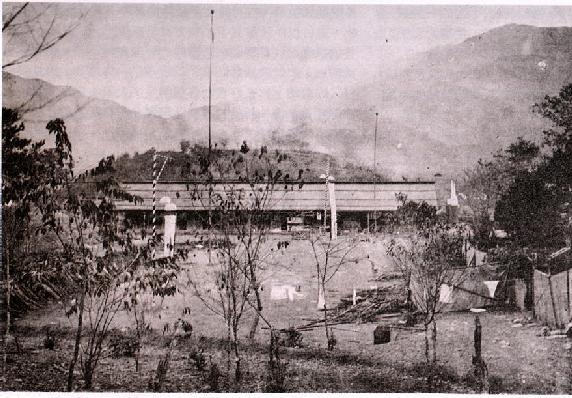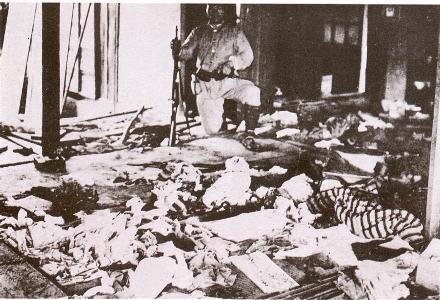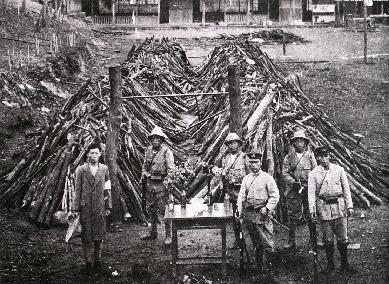|
||||||||
|
Although the roots of the Wushe Incident of 1930 stretch back to the earliest days of Hoklo migration and beyond, the immediately preceding days provided the climate for harvest.
In early October of 1930 Chief Rudao Bai held a wedding banquet for his grandson Daho Mona Rudao. Animals were slaughtered for the feast and wine (samsu) was prepared and drunk. As the festivities proceeded the local policeman, the authority of the Japanese, came to visit the house of Chief Rudao Bai.
The young groom offered a cup of wine to the Japanese officer. The officer refused, later saying that Daho Mona Rudao's hands were soiled with blood from the slaughtered animals. The groom pulled the policeman towards him to insist that the officer partake of the festivities.
The Japanese officer struck Daho Mona Rudao with his stick. A fight ensued.
On the second day of the family wedding Mona Rudao took a flagon of wine to the the Japanese police officer's dwelling to make amends. The officer refused to accept this offering. Meanwhile the aggrieved groom spread the story of the affront by the Japanese overlord. Resentment, already simmering, was now ready to boil over.
|
||||||||
|
Wushe had been promoted as a model Japanese mountain village after the suppression of the Atayal in 1915. The scenery is beautiful and its location in the middle of Taiwan, near Puli in today's Nantou County, made it an ideal base for travel and for the control of mountain areas.
The Japanese had set up schools, police stations, post offices, hotels, hospitals and even a camphor association in the Wushe district. In 1930 there were 157 Japanese nationals, 111 'Chinese', and 144 camphor workers living in the Wushe district. There were also 11 communities of the Taiyal race living in the Wushe district : they numbered 2,178 people.
|
||||||||
|
|
||||||||
|
Wushe Primary School shortly after the incident |
||||||||
|
The day of 27 October 1930 was the sports day for Wushe Primary School. Because of its comparative ease of access from the plains, many visitors were expected.
Before dawn on 27 October 1930 Chief Rudao Bai had assembled a group of braves and coordinated raids on the police outposts, the postal stations and other government offices. The Atayal were now in possession of firearms and ammunition the necessary weapons for an uprising against the Japanese oppressors. Spears and long sharp knives they already had.
At 8 a m in the morning the flag-raising ceremony took place as a band played the Japanese Imperial Anthem. The attendants stood silently in the cool of the morning : men, women and children.
Over 300 Atayal braves led by Chief Mona Rudao burst into the school and set about killing their enemy with ruthless determination. This was not a fight but a slaughter. If there was armed opposition it was only perfunctory and quickly overwhelmed. Most of the victims had been seemingly killed from behind by cuts to the throat.
The Japanese were easy to identify by their clothing. 134 Japanese nationals were killed, 215 Japanese nationals were injured. Only two 'Chinese' died : one was a young Taiwanese girl who was dressed in a kimono.
|
||||||||
|
|
||||||||
|
Sheltering inside the classrooms proved little defence from the warriors
|
||||||||
|
The Japanese authorities were stunned. The aborigines in the Wushe area had been considered amongst the best 'tamed'. Yet among the assailants were two low-ranking Atayal policemen called Hanaoka Ichiro and Hanaoka Jiro though they were not related. They had recently taken wives in Japanese sponsored wedding ceremonies.
The previously liberal Japanese authorities were forced to react quickly and with crushing force. A massive military response was mobilised within hours of the news reaching Taihoku (Taipei) to ensure that full and absolute vengeance would be taken.
For the victims' families and for the inhabitants of Wushe there could only be grief after the events of 27 October 1930.
|
||||||||
|
|
||||||||
|
The funeral pyres at Wushe Primary School Photo : 300 Years' Taiwan History |
||||||||
|
||||||||


